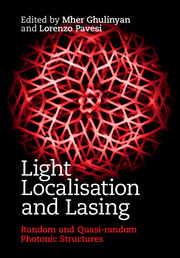Book contents
- Frontmatter
- Contents
- List of contributors
- Preface
- 1 Light propagation and emission in complex photonic media
- 2 Transport of localized waves via modes and channels
- 3 Modes structure and interaction in random lasers
- 4 Ordered and disordered light transport in coupled microring resonators
- 5 One-dimensional photonic quasicrystals
- 6 2D pseudo-random and deterministic aperiodic lasers
- 7 Three-dimensional photonic quasicrystals and deterministic aperiodic structures
- 8 Cavity quantum electrodynamics with three-dimensional photonic band gap crystals
- References
- Index
3 - Modes structure and interaction in random lasers
Published online by Cambridge University Press: 18 December 2014
- Frontmatter
- Contents
- List of contributors
- Preface
- 1 Light propagation and emission in complex photonic media
- 2 Transport of localized waves via modes and channels
- 3 Modes structure and interaction in random lasers
- 4 Ordered and disordered light transport in coupled microring resonators
- 5 One-dimensional photonic quasicrystals
- 6 2D pseudo-random and deterministic aperiodic lasers
- 7 Three-dimensional photonic quasicrystals and deterministic aperiodic structures
- 8 Cavity quantum electrodynamics with three-dimensional photonic band gap crystals
- References
- Index
Summary
From lasers to random lasers
Lasers are among the most useful and popular of all optical devices, with countless applications ranging from biology to astronomy. First predicted by Letokhov [292] and measured experimentally by Lawandy [269] and others [174, 319], random lasers [495, 529] connected for the first time the physics of ordinary lasers with that of disordered systems, boosting spectacularly in the early 1990s the interest of the scientific community in complex photonics. The possibility of using intrinsically disordered structures to create novel optical systems is attractive, not only from the applications point of view, but also fundamentally, allowing scientists to connect the theoretical paradigms of complexity, nonlinearity, disorder, and even glass physics with photonics.
Laser stands for Light Amplification by Stimulated Emission of Radiation, thus the amplifier is its fundamental element. A coherent optical amplifier is capable of increasing the amplitude of an optical field while maintaining its phase. If a monochromatic beam is injected into such a device the output will have the same frequency, while the phase can be the same or shifted by a fixed amount. In contrast, an amplifier that increases the intensity of an optical wave without preserving the phase is an incoherent amplifier. An amplifier based on stimulated emission is coherent: the stimulation process allows a photon in a given mode to induce an atom lying in an excited state to undergo a transition to a lower energy level, emitting a photon that is identical to the exciting photon, thus preserving frequency, direction, polarization and phase. If stimulation happens in a material in which the population is inverted (i.e. the majority of the atoms lie at the excited level), then an avalanche process in which every photon creates a duplicate of itself, is ignited exponentially, increasing the amplitude in the mode.
- Type
- Chapter
- Information
- Light Localisation and LasingRandom and Pseudo-random Photonic Structures, pp. 54 - 79Publisher: Cambridge University PressPrint publication year: 2014



